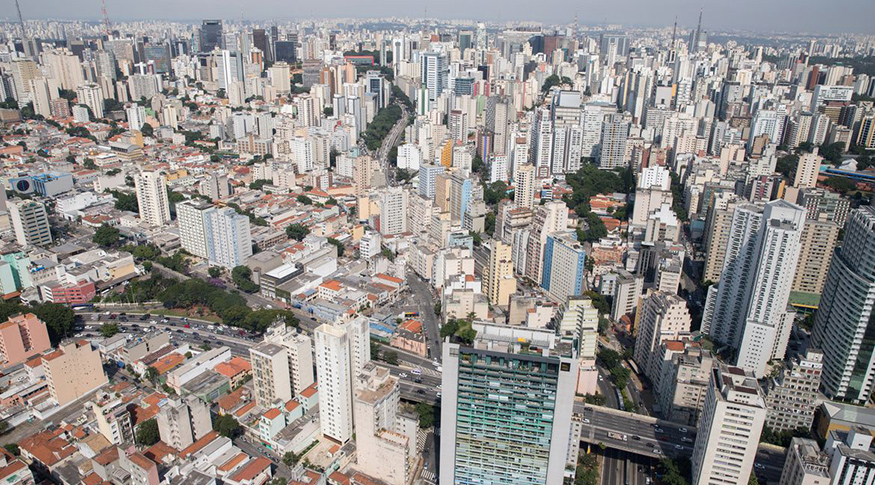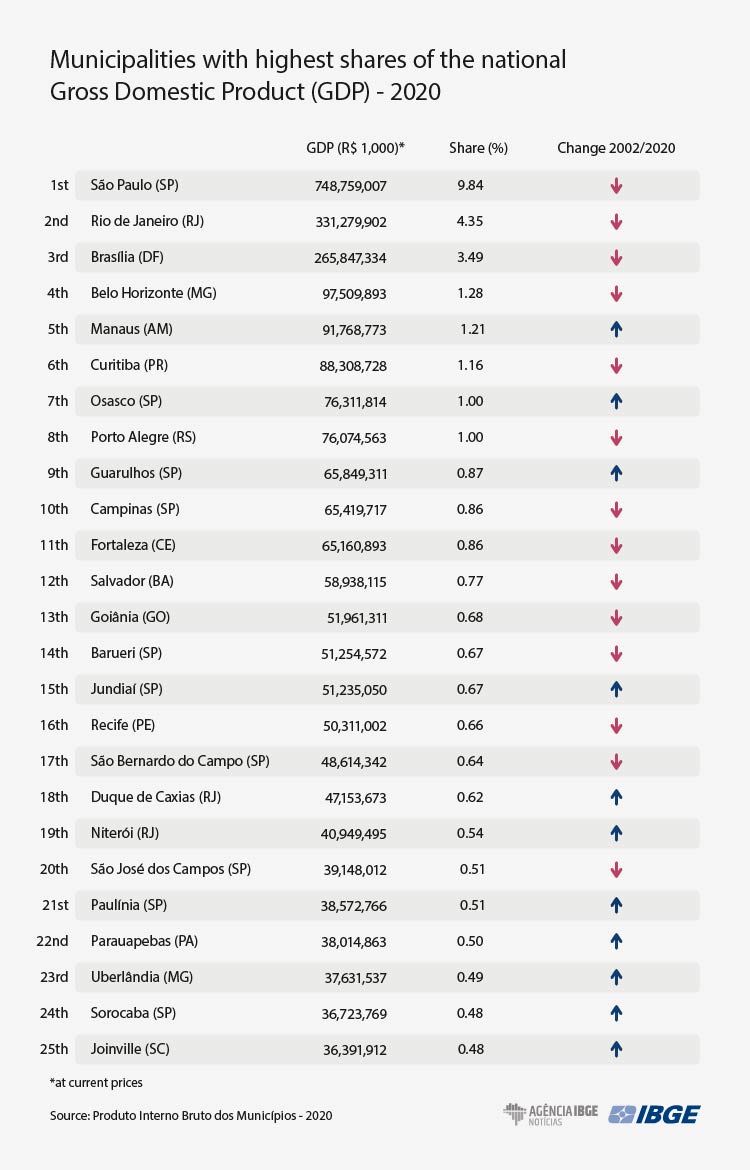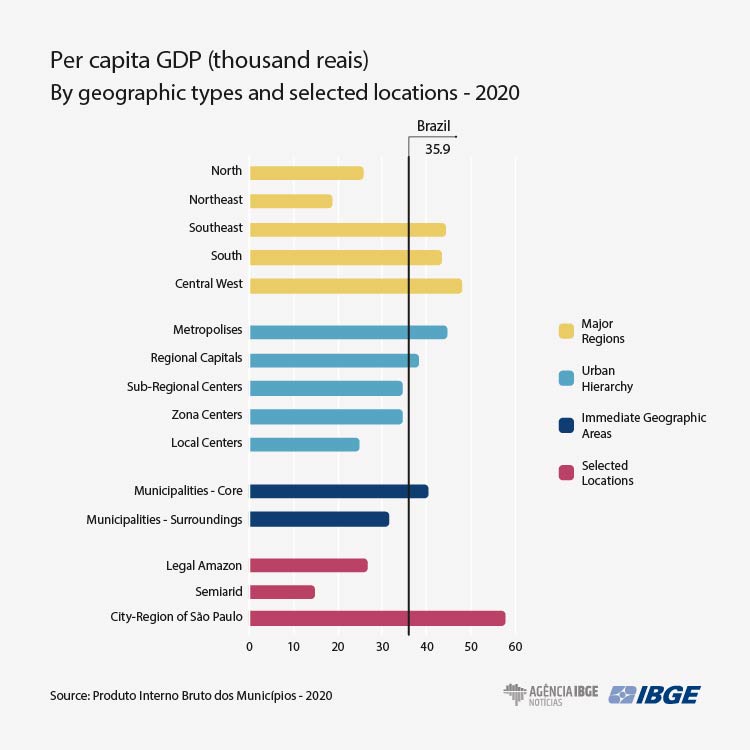GDP of Municipalities
Pandemic causes GDP to drop in big urban centers in 2020
December 16, 2022 10h00 AM | Last Updated: December 20, 2022 05h30 PM
Highlights
- In 2020, São Paulo held 9.8% of the Gross Domestic Product (GDP) in the country, with a decrease of 0.5 percentage points from 2019.
- Besides the capital of São Paulo, Rio de Janeiro, Brasília, Curitiba and São José dos Pinhais were the municipalities with biggest decrease in participation.
- The five municipalities that recorded increase in their share of national GDP were Parauapebas, Canaã dos Carajás, Manaus, Saquarema and Itajaí.
- Nine municipalities accounted for almost 25% of the national GDP: São Paulo, Rio de Janeiro, Brasília, Belo Horizonte, Manaus, Curitiba, Osasco, Porto Alegre and Guarulhos.
- Capitals have 11 of the 25 biggest national GDPs. Among the remaining 14, 12 are in the Southeast Region; 9 in São Paulo, 2 in Rio de Janeiro and 1 in Minas Gerais.
- The São Paulo City-Region has 23.5% of the national GDP, against 9.9% of the Legal Amazon and 5.4% of the Semiarid Region. These three regions have major economic differences, but a population of about 28 million residents.
- Public Administration is the main economic activity in most municipalities in the Legal Amazon and the Semiarid Region. In the City-Region of São Paulo, other services prevail, that is, Services, except Trade and Public Administration.

The five municipalities with the biggest decreases in participation in national GDP, between 2019 and 2020, were São Paulo (9.8%), with a decrease of 0.5 percentage points; Rio de Janeiro (4.4%), 0.4 percentage points; Brasília (3.5%), 0.2 percentage points; Curitiba (1.2%), 0.1 percentage points; and São José dos Pinhais (0.3%), with a decrease of 0.1 percentage points. These five municipalities correspond to almost 20% of the total of the GDP in the country, in the country.
“São Paulo and Rio de Janeiro are the Federation Units with biggest decreases in participation in regional accounts in 2020. Therefore, together with that result, among municipalities are state capitals as the places recording major decreases. The reduced share of services as a determining factor for these results, especially the trade activity in a pandemic context in 2020,” says Luiz Antonio de Sá, analyst of Regional Accounts at the IBGE.
On the other hand, the five main increases were registered by Parauapebas (0.5%) and Canaã dos Carajás (0.3%), both in Pará, which grew by 0.2 percentage points, besides Manaus (1.2%), in Amazonas; Saquarema (0,2%), in Rio de Janeiro; and Itajaí (0,4%), in Santa Catarina, all of them with an increase of about 0.1 percentage points.
“We can also associate the result with regional accounts, since Pará was the Federation Unit with highest increase in share; Parauapebas and Canaã dos Carajás were number one and two in the ranking of municipalities, driven by the activity extraction of iron ore. Manaus, which also followed a trend to decrease in the activity of services observed in other capitals, had its result mitigated by manufacturing industry, with a highlight to manufacture of computer equipment, concentrated in the municipality.”
The analyst also calls attention to some of the main impacts in the first year of the pandemic in the results of municipalities. “Figures in 2020 evidence that the effects of the COVID-19 on municipal economies changed according to the relevance of their service activities, mainly face-to-face ones. These services gather the activities with major decreases in shares in the country, between 2019 and 2020, being also ones mostly affected by social distancing measures and reduction of demand throughout the year.”

Concentration of the national economy from 2002 records decrease
In 2020, nine municipalities accounted for almost 25% of the national GDP and for 15.3% of the Brazilian population: São Paulo, Rio de Janeiro, Brasília, Belo Horizonte, Manaus, Curitiba, Osasco, Porto Alegre and Guarulhos. The 82 municipalities with the highest GDPs made up, approximately, 50% of the total GDP and 35.8% of the country’s population. In 2002, only four municipalities, São Paulo, Rio de Janeiro, Brasília and Belo Horizonte, represented about ¼ of the national economy.
“Among the 25 biggest municipalities in terms of GDP figures, there is a decrease in participation against 2002. In spite of that, it is worth pointing out that the municipality of São Paulo, alone, accounts for almost 10% of the national GDP, followed by Rio de Janeiro (4.4%). We observe that among the 14 non-capital municipalities in the list, 12 are part of the Southeast Region, being 9 of them in São Paulo, 2 of them in Rio de Janeiro and 1 in Minas Gerais,” says Luiz Antonio.

Per capita GDP in the Central South Region exceeds national average
The highest per capita GDP figures, in 2020, como from big urban centers in the Central South, and, also, from some Regions with strong agricultural activity and a small population, such as the Legal Amazon South border, in the Central area of Mato Grosso and, also, municipalities in the South of Goiás, east of Mato Grosso do Sul, west of Bahia and upper course of the Parnaíba River. The calculation of per capita GDP of municipalities uses the resident population estimated by municipality, with a data of reference of July 1st, 2020, sent to the Brazilian Federal Course of Accounts (TCU).
“In the list of highest per capita GDPs, there are municipalities which do not necessarily have the highest shares in the country, but have a combination between low participation of the population and industries that concentrate capital, such as extraction of iron ore, hydroelectrical companies and manufacturing industries,” Mr. de Sá analyzes.
In big urban clusters, in 2020, the highest ratio of per capita GDP (which is per capita GDP of the place divided by Brazil’s per capita GDP, R$ 35,935.74) is that of the urban cluster of Campinas/SP, followed by Brasília/DF, São Paulo/SP, São José dos Campos/SP and Sorocaba/SP. That is a similar order to the one in 2002. Throughout the time series, the highest per capita GDP rations recorded a relative decrease, and converged to the national average.
In 2020, the reduction of per capita GDP regional inequality can also be noticed in Semiarid regions, in the Legal Amazon and in the City Region of the São Paulo Area. In 2002, the per capita GDP ratios for the Semiarid region and the Legal Amazon were 0.32 and 0.58, respectively. In 2019, the Semiarid region had a ratio of 0.40, and the Legal Amazon, 0.66. In 2020, this region recorded indexes of 0.41 and 0.75. The City region of São Paulo, on the other hand, corresponded to 1.85 of the national figure in 2002; to 1.66 in 2019 and, in 2020, it fell to 1.61.

City-Region of São Paulo holds 23.4% of the national GDP
In the regional comparison between the City-Region of São Paulo, Legal Amazon and Semiarid Region, it is possible to highlight the differences between the GDP and surfaces that form each region. The City-Region of São Paulo had a GDP of R$ 1,786.50 billion, which corresponds to 23.5% of the national economy, in an area of 23,785 km². The Legal Amazon had a GDP of R$ 752.93 billion, corresponding to 9.9% of the national result, with an area of 5,030,137 km². Finally, the Semiarid region had a GDP of R$ 414.02 billion, which is equivalent to 5.4% of the country’s and a surface area of 1,128,272 km².
“These three areas, City-Region of São Paulo, Legal Amazon and Semiarid, have a similar number of residents, 31, 28 and 28 million, respectively. When we consider the Legal Amazon, it is worth pointing out there are Indian reservations and environmental preservation, which means the surface is not fully occupied,” explains Marcelo Delizio Araujo, geographer at the IBGE./p>
Public Administration is predominant in the Legal Amazon and Semiarid Region
In an analysis of the main economic activities, in the Legal Amazon, formed by 772 municipalities, the predominant activity in 506 of them was public administration; in 132, crops; in 51, the remaining services (except trade and public administration); and, in 28, livestock. In the semiarid region, formed by 1262 municipalities, the main activity, was public administration, whereas in the City-Region of São Paulo, formed by 92 municipalities, the activity other services was predominant in 81.
“It is worthy of mention that the remaining services (except trade and public administration) are still the main economic activity in most municipalities of the City-Region of São Paulo, also considering the decrease in participation of this activity during the pandemic, whereas public administration of the main economic activity in most municipalities in the Semiarid region and Legal Amazon, despite a more general profile,” Mr. Araújo analyzes.




















